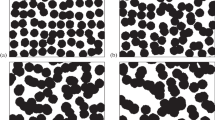Abstract
The mass diffusion process inside a porous medium is difficult for numerical simulation due to complex and stochastic nature of its structure. Based on the lattice Boltzmann method and reconstruction technology, this article presents an approach for simulating mass diffusion process and predicting the effective mass diffusivity in porous media, which is validated by comparing theoretical and experimental data. The concentration distribution and effective mass diffusivity inside porous media can be obtained.















Similar content being viewed by others
References
Cao Y, Faghri A (1994) Analytical solutions of flow and heat transferin a porous structure with partial heating and evaporation on the upper surface. Int J Heat Mass Transf 36(10):1525–1533
Cao Y, Faghri A (1994) Conjugate analysis of a flat-plate type evaporator for capillary pumped loop with three-dimensional vapor flow in the groove. Int J Heat Mass Transf 37(3):401–409
Tarik K, John G (2006) Numerical analysis of heat and mass transfer in the capillary structure of a loop heat pipe. Int J Heat Mass Transf 49:3211–3220
Ren C, Wu QS, Hu MB (2007) Heat transfer with flow and evaporation in loop heat pipe’s wick at low or moderate heat fluxes. Int J Heat Mass Transf 50:2296–2308
Qian JY, Li Q, Xuan YM (2004) A novel method to determine effective thermal conductivity of porous material. Sci Chin Ser E Technol Sci 47:716–724
Bhattacharya A, Calmidi VV, Mahajan RL (2002) Thermophysical properties of high porosity metal foams. Int J Heat Mass Transf 45(5):1017–1031
Paek JW, Kang BH, Kim SY, Hyun JM (2000) Effective thermal conductivity and permeability of aluminum foam materials. Int J Thermophys 21(2):453–464
Manwart C, Aaltosalmi U, Koponen A, Hilfer R, Timonen J (2002) Lattice-Boltzmann and finite-difference simulations for the permeability for three-dimensional porous media. Phys Rev E 66(1):016702/1-11
Kim YM, Harrad S, Harrison RM (2001) Concentrations and sources of VOCs in uran domestic and public microenvironments environ. Sci Technol 35:997–1004
Meininghaus R, Salthammer T, Knoppel H (1999) Interaction of volatile organic compounds with indoor materials—a small-scale screening method. Atmos Environ 33:2395–2401
Molhave L (1989) Sick buildings and other buildings with indoor climate problems. Environment 15:473–482
Cox SS, Zhao D, Little JC (2001) Measuring partition and diffusion coefficients for volatile organic compounds in vinyl flooring. Atmos Environ 35:709–714
Haghighat F, Zhang Y (1999) Modeling of emission of volatile organic compounds from building materials—estimation of gas-phase mass transfer coefficient. Build Environ 37:1349–1360
Lee CS, Haghighat F, Ghaly WS (2005) A study on VOC source and sink behavior in porous building materials—analytical model development and assessment. Indoor Air 15:183–196
Little JC, Hodgson AT, Gadgil AJ (1994) Modeling emissions of volatile organic compounds from new carpets. Environment 28:227–234
Hu HP, Zhang YP, Wang XK, Little JC (2007) An analytical mass transfer model for predicting VOC emissions from multi-layered building materials with convective surface on both sides. Int J Heat Mass Transf 50:2069–2077
Xiong JY, Zhang YP, Wang XK, Chang DW (2008) Macro-meso two scale model for predicting the VOC diffusion coefficients and emission characteristics of porous building materials. Atmos Environ 42:5278–5290
Frank PI, David PD (2002) Fundamentals of heat and mass transfer, 5th edn. Wiley, New York, pp 859–870
Benzi R, Succi S, Vergassola M (1992) The lattice-Boltzmann equation: theory and applications. Phys Rep 222:145–197
Qian Y, Succi S, Orszag S (1995) Resent advances in lattice Boltzmann computing. Annu Rev Comp Phys 3:195–242
Chen S, Doolen GD (1998) Lattice Boltzmann method for fluid flows. Annu Rev Fluid Mech 30:329–364
Xuan YM, Li Q, Ye M (2007) Investigations of convective heat transfer in ferrofluid microflows using lattice-Boltzmann approach. Int J Therm Sci 46:105–111
Li HN, Pan CX, Miller CT (2005) Pore-scale investigation of viscous coupling effects for two-phase flow in porous media. Phys Rev E 72:026705/1-14
Li Q, Zheng CG, Wang NC, Shi BC (2001) LBGK simulations of turing patterns in CIMA model. J Sci Comput 16:121–134
Toffoli T, Margolus N (1990) Invertible cellular automata: a review. Physica D 45:229–253
Kang QJ, Zhang DX, Lichtner PC, Tsimpanogiannis IN (2004) Lattice Boltzmann model for crystal growth from supersaturated solution. Res Lett 31:L21604
Wang J, Wang M, Li Z (2007) A lattice Boltzmann algorithm for fluid–solid conjugate heat transfer. Int J Therm Sci 46:228–234
Wang M, Chen SY (2007) Electroosmosis in homogeneously charger micro- and nano-scale random porous media. J Colloid Interface Sci 314:264–273
Jose AR, Salvador NM, Jesús GT (1996) Calculation of the effective diffusivity of heterogeneous media using the lattice-Boltzmann method. Phys Rev E 53:2298–2303
Maxwell JC (1954) A treatise on electricity and magnetism, 3rd edn. Dover, New York
Nield DA (1991) Estimation of the stagnant thermal conductivity of saturated porous media. Int J Heat Mass Transf 34:1575–1576
Guo ZL, Shi BC, Zheng CG (2002) A coupled lattice BGK model for Boussinesq equations. Int J Numer Methods Fluids 39:325–342
Zhao K, Li Q, Xuan YM (2009) Investigation on the three-dimensional multiphase conjugate conduction problem inside porous wick with the lattice Boltzmann method. Sci Chin Ser E Technol Sci 52(10):2973–2980
Shi MH, Li XC (2006) Determination of effective thermal conductivity for polyurethane foam by use of fractal method. Sci Chin Ser E Technol Sci 49:468–475
Acknowledgments
This study was supported by National Natural Science Foundation of China (Grant nos. 50478012, 50725620). The authors would like to thank the helpful discussions from Dr. J. Y. Xiong, and Prof. Y. P. Zhang about the VOCs problem. A special thanks is also given to Dr. Wang for his patient and useful discussions on the QSGS method.
Author information
Authors and Affiliations
Corresponding author
Additional information
Dedicated to Professor Dr. Ing. Dr. h.c. mult. Karl Stephan on the occasion of his 80th birthday.
Rights and permissions
About this article
Cite this article
Xuan, Y.M., Zhao, K. & Li, Q. Investigation on mass diffusion process in porous media based on Lattice Boltzmann method. Heat Mass Transfer 46, 1039–1051 (2010). https://doi.org/10.1007/s00231-010-0687-2
Received:
Accepted:
Published:
Issue Date:
DOI: https://doi.org/10.1007/s00231-010-0687-2




